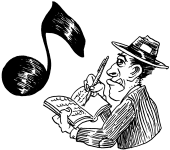I.
I just published a novel about music. Early in the process of writing it, I was warned by a similarly music-obsessive friend that “writing about music is like dancing about architecture.”[1] Since that first somewhat menacing reminder, I’ve heard the line frequently.
At first blush, the claim is a smugly dismissive one: verbal descriptions of music are doomed to be pointlessly, perhaps even ridiculously, inferior to actual music. As a reader, I resisted this idea; it just felt false, though I couldn’t quite say why. But as a writer, this assertion paralyzed me: I didn’t want to waste two or three years trying to produce something that could not be produced.[2] I tried to put aside the line’s foundational snobbery (“My music is too ineffable for your inky art”), and then, reassuringly, it seemed like nothing more than a truism: words are words and music is music. And perfume is perfume; paintings are paintings; facial features are facial features. Yet writers are never counseled against attempting to evoke paintings or smells or faces or feelings or buildings or the nonmelodic sounds of jackhammers, thunder, or snoring. What was so elusive about music that it couldn’t be captured by words?
II.
I decided to consult my bookshelf to see how those who came before me had tackled the problem of writing about music.
The most common—and least risky—means of injecting music into fiction is to treat the music as a prop, an inaudible ornament, in order to set a scene, establish a social milieu, earn a little plausibility. For example: “That year, all the freshmen in my dorm owned Bowie’s Changes One album and Squeeze’s Singles: 45’s and Under.” Or: “While she peeled potatoes and waited to hear news of the attack at Normandy, the radio played ‘Don’t Sit under the Apple Tree.’” Or: “She went out dancing that night and met him at a new club; it was the kind of place where Norwegian DJs sampled Astrud Gilberto and Messiaen over Ibiza beats.”
Despite hand-wringing that contemporary fiction is brand obsessed, this trick is hardly a recent innovation. In Emma, Jane Austen has a character dropping sheet music onto the piano (the brand of which is duly noted) and mentioning John Baptist Cramer by name, because you just know what kind of girls listened to him.
And that, of course, is the price of this sort of pop-referencing: it dates the book. At first the reference dates the story efficiently (if all the frosh have Singles: 45’s and Under, if they own and play full albums at all, it must...
You have reached your article limit
Sign up for a digital subscription and continue reading all new issues, plus our entire archives, for just $1.50/month.
Already a subscriber? Sign in





